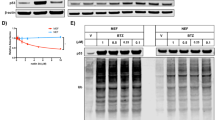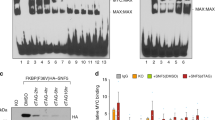Abstract
We previously identified a novel p53-induced mouse gene, wig-1, that encodes a 290 amino acid zinc finger protein (Varmeh-Ziaie et al., 1997). Here we have identified and characterized the human homolog of mouse wig-1. The human wig-1 protein is 87% identical to the mouse protein and contains three zinc finger domains and a putative nuclear localization signal. Human wig-1 mRNA and protein is induced following activation of wild type p53 expression in our BL41-ts p53 Burkitt lymphoma cells. Wig-1 is also induced in MCF7 cells following treatment with the DNA-damaging agent mitomycin C. Northern blotting detected low levels of wig-1 mRNA in normal human tissues. Fluorescence in situ hybridization mapped wig-1 to human chromosome 3q26.3-27. FLAG-tagged human wig-1 localizes to the nucleus. Ectopic overexpression of human wig-1 inhibits tumor cell growth in a colony formation assay. These results suggest that human wig-1 has a role in the p53-dependent growth regulatory pathway.
This is a preview of subscription content, access via your institution
Access options
Subscribe to this journal
Receive 50 print issues and online access
$259.00 per year
only $5.18 per issue
Buy this article
- Purchase on Springer Link
- Instant access to full article PDF
Prices may be subject to local taxes which are calculated during checkout






Similar content being viewed by others
References
Allen DG, White DJ, Hutchins AM, Scurry JP, Tabrizi SN, Garland SM, Armes JE . 2000 Br. J. Cancer 83: 1659–1663
Attardi LD, Reczek EE, Cosmas C, Demicco EG, McCurrach ME, Lowe SW, Jacks T . 2000 Genes Dev. 14: 704–718
Balsara BR, Sonoda G, du Manoir S, Siegfried JM, Gabrielson E, Testa JR . 1997 Cancer Res. 57: 2116–2120
Bates S, Vousden KH . 1999 Cell. Mol. Life Sci. 55: 28–37
Brzoska PM, Levin NA, Fu KK, Kaplan MJ, Singer MI, Gray JW, Christman MF . 1995 Cancer Res. 55: 3055–3059
Chao C, Saito S, Kang J, Anderson CW, Appella E, Xu Y . 2000 EMBO J. 19: 4967–4975
Chung DC, Brown SB, Graeme-Cook F, Tillotson LG, Warshaw AL, Jensen RT, Arnold A . 1998 Cancer Res. 58: 3706–3711
el-Deiry WS . 1998 Semin. Cancer Biol. 8: 345–357
Faulkner SW, Leigh DA, Oosterhuis JW, Roelofs H, Looijenga LH, Friedlander ML . 2000 Br. J. Cancer 83: 729–736
Fedorova L, Kost-Alimova M, Gizatullin RZ, Alimov A, Zabarovska VI, Szeles A, Protopopov AI, Vorobieva NV, Kashuba VI, Klein G, Zelenin AV, Sheer D, Zabarovsky ER . 1997 Eur. J. Hum. Genet. 5: 110–116
Finerty PJ, Bass BL . 1997 J. Mol. Biol. 271: 195–208
Finerty PJ, Bass BL . 1999 Biochemistry 38: 4001–4007
Forozan F, Mahlamaki EH, Monni O, Chen Y, Veldman R, Jiang Y, Gooden GC, Ethier SP, Kallioniemi A, Kallioniemi OP . 2000 Cancer Res. 60: 4519–4525
Gottlieb TM, Oren M . 1998 Semin. Cancer Biol. 8: 359–368
Greasley PJ, Bonnard C, Amati B . 2000 Nucleic Acids Res. 28: 446–453
Haldar S, Negrini M, Monne M, Sabbioni S, Croce CM . 1994 Cancer Res. 54: 2095–2097
Harris CC . 1996 J. Natl. Cancer Inst. 88: 1442–1455
Heselmeyer K, Macville M, Schrock E, Blegen H, Hellstrom AC, Shah K, Auer G, Ried T . 1997 Genes Chromosomes Cancer 19: 233–240
Israeli D, Tessler E, Haupt Y, Elkeles A, Wilder S, Amson R, Telerman A, Oren M . 1997 EMBO J. 16: 4384–4392
Kruzelock RP, Murphy EC, Strong LC, Naylor SL, Hansen MF . 1997 Cancer Res. 57: 106–109
Lin Y, Ma W, Benchimol S . 2000 Nat Genet. 26: 122–127
Miyashita T, Reed JC . 1995 Cell 80: 293–299
Murphy M, Hinman A, Levine AJ . 1996 Genes Dev. 10: 2971–2980
Oda E, Ohki R, Murasawa H, Nemoto J, Shibue T, Yamashita T, Tokino T, Taniguchi T, Tanaka N . 2000a Science 288: 1053–1058
Oda K, Arakawa H, Tanaka T, Matsuda K, Tanikawa C, Mori T, Nishimori H, Tamai K, Tokino T, Nakamura Y, Taya Y . 2000b Cell 102: 849–862
Ohki R, Nemoto J, Murasawa H, Oda E, Inazawa J, Tanaka N, Taniguchi T . 2000 J. Biol. Chem. 275: 22627–22630
Owen-Schaub LB, Zhang W, Cusack JC, Angelo LS, Santee SM, Fujiwara T, Roth JA, Deisseroth AB, Zhang WW, Kruzel E et al . 1995 Mol. Cell. Biol. 15: 3032–3040
Polyak K, Xia Y, Zweier JL, Kinzler KW, Vogelstein B . 1997 Nature 389: 300–305
Prisco M, Hongo A, Rizzo MG, Sacchi A, Baserga R . 1997 Mol. Cell. Biol. 17: 1084–1092
Ramqvist T, Magnusson KP, Wang Y, Szekely L, Klein G, Wiman KG . 1993 Oncogene 8: 1495–1500
Sambrook J, Fritsch EF, Maniatis T . 1989 Molecular Cloning: A Laboratory Manual Cold Spring Harbor Laboratory Press, Cold Spring Harbor, NY
Sattler HP, Lensch R, Rohde V, Zimmer E, Meese E, Bonkhoff H, Retz M, Zwergel T, Bex A, Stoeckle M, Wullich B . 2000 Prostate 45: 207–215
Sherr CJ . 1998 Genes. Dev. 12: 2984–2991
Starostik P, Greiner A, Schultz A, Zettl A, Peters K, Rosenwald A, Kolve M, Muller-Hermelink HK . 2000 Blood 95: 1180–1187
Varmeh-Ziaie S, Okan I, Wang Y, Magnusson KP, Warthoe P, Strauss M, Wiman KG . 1997 Oncogene 15: 2699–2704
Venter JC, Adams MD, Myers EW, Li PW, Mural RJ, Sutton GG, Smith HO, Yandell M, Evans CA, Holt RA, Gocayne JD, Amanatides P, Ballew RM, Huson DH, Wortman JR, Zhang Q, Kodira CD, Zheng XH, Chen L, Skupski M, Subramanian G, Thomas PD, Zhang J, Gabor Miklos GL, Nelson C, Broder S, Clark AG, Nadeau J, McKusick VA, Zinder N, Levine AJ, Roberts RJ, Simon M, Slayman C, Hunkapiller M, Bolanos R, Delcher A, Dew I, Fasulo D, Flanigan M, Florea L, Halpern A, Hannenhalli S, Kravitz S, Levy S, Mobarry C, Reinert K, Remington K, Abu-Threideh J, Beasley E, Biddick K, Bonazzi V, Brandon R, Cargill M, Chandramouliswaran I, Charlab R, Chaturvedi K, Deng Z, Di Francesco V, Dunn P, Eilbeck K, Evangelista C, Gabrielian AE, Gan W, Ge W, Gong F, Gu Z, Guan P, Heiman TJ, Higgins ME, Ji RR, Ke Z, Ketchum KA, Lai Z, Lei Y, Li Z, Li J, Liang Y, Lin X, Lu F, Merkulov GV, Milshina N, Moore HM, Naik AK, Narayan VA, Neelam B, Nusskern D, Rusch DB, Salzberg S, Shao W, Shue B, Sun J, Wang Z, Wang A, Wang X, Wang J, Wei M, Wides R, Xiao C, Yan C, et al . 2001 Science 291: 1304–1351
Yang M, May WS, Ito T . 1999 J. Biol. Chem. 274: 27399–27406
Zhu J, Chen X . 2000 Mol. Cell. Biol. 20: 5602–5618
Acknowledgements
This work was supported by grants from the Swedish Cancer Society (Cancerfonden), Åke Wibergs Stiftelse, and Karolinska Institute Funds. We also thank David Israeli and Moshe Oren, Weizmann Institute of Science, Rehovot, Israel, for communicating unpublished data.
Author information
Authors and Affiliations
Corresponding author
Rights and permissions
About this article
Cite this article
Hellborg, F., Qian, W., Mendez-Vidal, C. et al. Human wig-1, a p53 target gene that encodes a growth inhibitory zinc finger protein. Oncogene 20, 5466–5474 (2001). https://doi.org/10.1038/sj.onc.1204722
Received:
Revised:
Accepted:
Published:
Issue Date:
DOI: https://doi.org/10.1038/sj.onc.1204722
Keywords
This article is cited by
-
Consequences of Zmat3 loss in c-MYC- and mutant KRAS-driven tumorigenesis
Cell Death & Disease (2020)
-
Significant improvement of miRNA target prediction accuracy in large datasets using meta-strategy based on comprehensive voting and artificial neural networks
BMC Genomics (2019)
-
The Polycomb complex PRC2 supports aberrant self-renewal in a mouse model of MLL-AF9;NrasG12D acute myeloid leukemia
Oncogene (2013)
-
Wig1 prevents cellular senescence by regulating p21 mRNA decay through control of RISC recruitment
The EMBO Journal (2012)
-
Wig-1, a novel regulator of N-Myc mRNA and N-Myc-driven tumor growth
Cell Death & Disease (2012)



